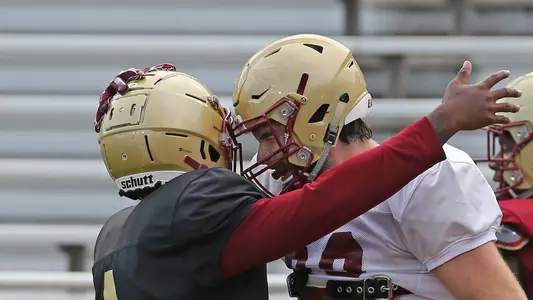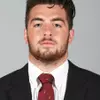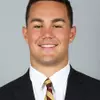
Photo by: John Quackenbos
2017 BC Football Camp Insider: Tight Ends
August 23, 2017 | Football, #ForBoston Files
It's a revolutionary position where BC is ready to change the game.
The past decade created a renaissance in college football. Formations became diversified as strategic thinking became more involved. The concept of how a particular position played changed forever, with each spot on a roster requiring new blends of attributes.
The clearest example is at tight end. The tight end used to be a smaller version of an offensive lineman, the type of player who sealed away tackles and created wider gaps for runners. Occasionally a pass catcher, they were simply more agile to create protections by taking on more agile and faster defenders such as linebackers. And after years of transitioning between offensive styles, Boston College now has a room full of tight ends who can do just that.
"Tommy Sweeney is on the field all the time," head coach Steve Addazio said. "He's an every down player. (Tommy), Chris Garrison and Korab Idrisi are every down players. They're tough to handle. My fear right now is that they're getting too many reps in practice, but I think we do a good job of rotating tight ends with our (first team units) and rolling everyone out there."
A formerly underutilized position is now enduring its most dramatic evolution. Big, athletic presences are required to be out on a pass pattern more often than they block, though the requirement is still there. They are a team's wild card because they have to be more versatile than arguably any other player on the field.
"We're heavily used in the offense this year," Sweeney said. "We're big components in play action and dropbacks, so with young quarterbacks, we're big targets and part of the game (that goes) over the middle and out into the flats. The goal is to be easy for them to see."
At Boston College, the tight end is a unique position. With a run-first mentality, there's a greater need to block than there is at the run-and-gun, "Big 12" style offense. But with a developing passing game, there became a larger need to find athletes who could outjump defensive backs, outrun linebackers and outhustle even their own teammates.
That's why the Eagles employ several different types of tight end. A more traditional tight end lines up on the end of the offensive line, giving the appearance of a blocker or added lineman. It's raw horsepower exploding off the ball, with direction indicated by the defense's design.
They can also step back from the line and use motion, putting a player on the move before the play ever starts. It shifts looks and provides different areas of horsepower for run blocking while forcing a defense to either represent zone or man coverage depending on who goes with the motion player.
"If I'm going out on a pass, the first thing I need to see is where the defensive end and linebacker are lining up," Sweeney said. "If they're both on the line, it's going to be tough to get off the ball so I need to really find a way to do that. It's about reading the coverage, looking at one safety or two safety formations. That all helps figure out how I'm going to get into my route, if it's man-to-man or not. And if it's a running play, then I need to listen to the offensive line to hear how to block and try to go with what they're doing."
In certain formations, that might also include lining up in the backfield. BC can utilize a full-fledged fullback in the backfield, the lead blocker who provides a block to spring a running back. At 6'3" and 235 pounds, that's Colton Cardinal's job. A former linebacker and tight end in high school, he has the hands to catch a couple of passes but primarily initiates contact by simply plowing straight ahead.
Then there's the hybrid fullback-tight end, referred to as an H-back. An H-back lines up in the backfield, typically somewhere between the running back and the offensive line. They're typically tight ends who can get upfield through the line for short and intermediate passes, and they can expose vulnerabilities by forcing a defense into a rushing scheme.
"The tight end room is phenomenal," Addazio said. "We've got tight ends that are very multidimensional.
"They have to block like linemen and run like receivers," he said. "Big guys running like that can pull up, so we have to take care of those guys."
The H-back wasn't used as much by the Eagles in their traditional pro-style offense, but BC used it extensively in 2014. With Tyler Murphy at quarterback, the Eagles used Josh Bordner to expose holes in the second level, and he finished the season as the team's leading receiver. BC was an option-run offense that year, but Bordner snuck behind eight or nine-man fronts. He caught three touchdowns, finishing with 40 or more receiving yards in four games.
Sweeney's helped pave a road with athletes who can fulfill all of those roles. Idrizi is 6'3", 250 pounds, a player from the Bergen Catholic pipeline in New Jersey. Garrison is a 6'3", 240-pound presence who started two games last year at wide receiver, playing five games before fracturing his tibia at the end of a 44-yard catch against Buffalo. Jake Burt started a game in 2015 as a freshman before redshirting last season with an injury.
"It starts with (Frank Leonard), who is our tight ends coach," Sweeney said. "This is my fourth year working with him. I was recruited by him, and we've been working together ever since. In the tight ends room, we have seven guys who can go out and play. There are young guys who are mixing with older guys and everyone is just readying to go. The goal is to give the offense something on every play."
The clearest example is at tight end. The tight end used to be a smaller version of an offensive lineman, the type of player who sealed away tackles and created wider gaps for runners. Occasionally a pass catcher, they were simply more agile to create protections by taking on more agile and faster defenders such as linebackers. And after years of transitioning between offensive styles, Boston College now has a room full of tight ends who can do just that.
"Tommy Sweeney is on the field all the time," head coach Steve Addazio said. "He's an every down player. (Tommy), Chris Garrison and Korab Idrisi are every down players. They're tough to handle. My fear right now is that they're getting too many reps in practice, but I think we do a good job of rotating tight ends with our (first team units) and rolling everyone out there."
A formerly underutilized position is now enduring its most dramatic evolution. Big, athletic presences are required to be out on a pass pattern more often than they block, though the requirement is still there. They are a team's wild card because they have to be more versatile than arguably any other player on the field.
"We're heavily used in the offense this year," Sweeney said. "We're big components in play action and dropbacks, so with young quarterbacks, we're big targets and part of the game (that goes) over the middle and out into the flats. The goal is to be easy for them to see."
At Boston College, the tight end is a unique position. With a run-first mentality, there's a greater need to block than there is at the run-and-gun, "Big 12" style offense. But with a developing passing game, there became a larger need to find athletes who could outjump defensive backs, outrun linebackers and outhustle even their own teammates.
That's why the Eagles employ several different types of tight end. A more traditional tight end lines up on the end of the offensive line, giving the appearance of a blocker or added lineman. It's raw horsepower exploding off the ball, with direction indicated by the defense's design.
They can also step back from the line and use motion, putting a player on the move before the play ever starts. It shifts looks and provides different areas of horsepower for run blocking while forcing a defense to either represent zone or man coverage depending on who goes with the motion player.
"If I'm going out on a pass, the first thing I need to see is where the defensive end and linebacker are lining up," Sweeney said. "If they're both on the line, it's going to be tough to get off the ball so I need to really find a way to do that. It's about reading the coverage, looking at one safety or two safety formations. That all helps figure out how I'm going to get into my route, if it's man-to-man or not. And if it's a running play, then I need to listen to the offensive line to hear how to block and try to go with what they're doing."
In certain formations, that might also include lining up in the backfield. BC can utilize a full-fledged fullback in the backfield, the lead blocker who provides a block to spring a running back. At 6'3" and 235 pounds, that's Colton Cardinal's job. A former linebacker and tight end in high school, he has the hands to catch a couple of passes but primarily initiates contact by simply plowing straight ahead.
Then there's the hybrid fullback-tight end, referred to as an H-back. An H-back lines up in the backfield, typically somewhere between the running back and the offensive line. They're typically tight ends who can get upfield through the line for short and intermediate passes, and they can expose vulnerabilities by forcing a defense into a rushing scheme.
"The tight end room is phenomenal," Addazio said. "We've got tight ends that are very multidimensional.
"They have to block like linemen and run like receivers," he said. "Big guys running like that can pull up, so we have to take care of those guys."
The H-back wasn't used as much by the Eagles in their traditional pro-style offense, but BC used it extensively in 2014. With Tyler Murphy at quarterback, the Eagles used Josh Bordner to expose holes in the second level, and he finished the season as the team's leading receiver. BC was an option-run offense that year, but Bordner snuck behind eight or nine-man fronts. He caught three touchdowns, finishing with 40 or more receiving yards in four games.
Sweeney's helped pave a road with athletes who can fulfill all of those roles. Idrizi is 6'3", 250 pounds, a player from the Bergen Catholic pipeline in New Jersey. Garrison is a 6'3", 240-pound presence who started two games last year at wide receiver, playing five games before fracturing his tibia at the end of a 44-yard catch against Buffalo. Jake Burt started a game in 2015 as a freshman before redshirting last season with an injury.
"It starts with (Frank Leonard), who is our tight ends coach," Sweeney said. "This is my fourth year working with him. I was recruited by him, and we've been working together ever since. In the tight ends room, we have seven guys who can go out and play. There are young guys who are mixing with older guys and everyone is just readying to go. The goal is to give the offense something on every play."
Players Mentioned
Football: Head Coach Bill O'Brien Media Availability (October 16, 2025)
Thursday, October 16
Football: Turbo Richard Media Availability (October 16, 2025)
Thursday, October 16
Football: Sedarius McConnell Media Availability (October 16, 2025)
Thursday, October 16
Football: Head Coach Bill O'Brien Media Availability (October 14, 2025)
Tuesday, October 14


















